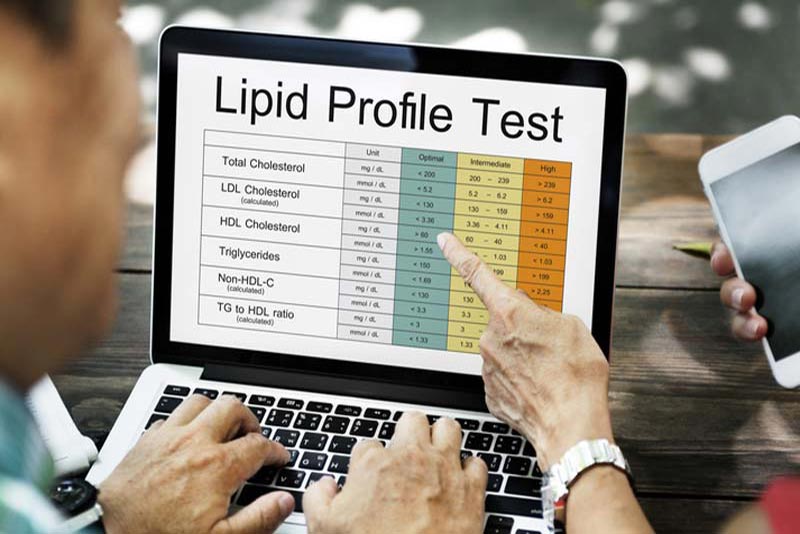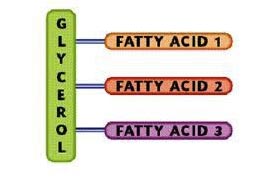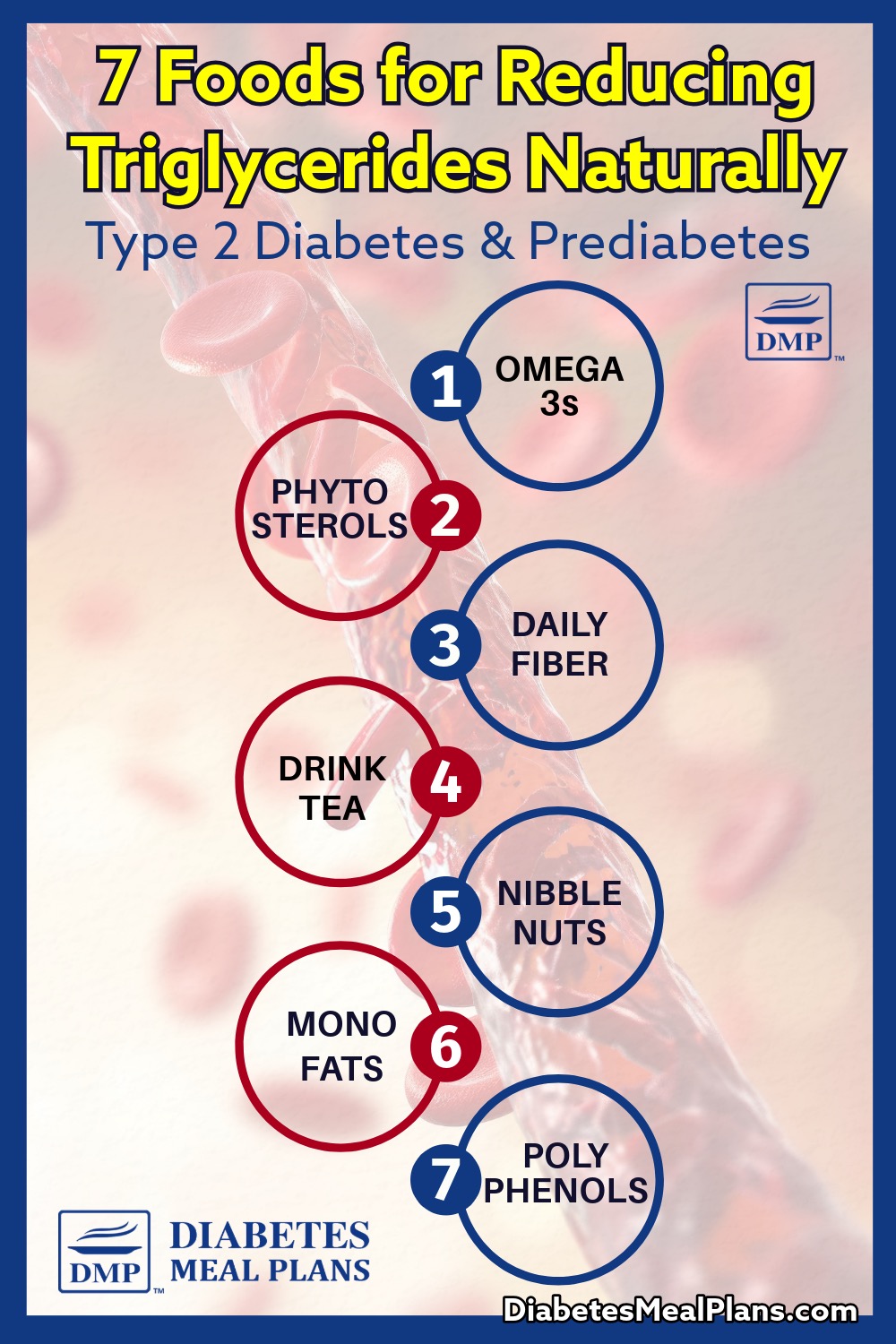Triglycerides are a type of fat found in your blood, which your body uses for energy. And they are connected to the foods you eat.
When you go for a cholesterol test you will also have your triglycerides measured. While they are only one measurement, what most people don’t know is that high triglycerides are a primary risk factor for cardiovascular disease.
This is because if triglycerides are high then LDL is likely to be small dense LDL particles. LDL is not “bad” as we’re commonly told, as there are two types of LDL, small dense and large bouyant. Small dense are the type of LDL that oxidizes and causes plaques in the arteries.
If you do come back with a high triglyceride reading, there are some foods and nutrition strategies that are known for reducing triglycerides naturally.

What Raises Triglyceride Levels?
Understanding what raises triglycerides is crucial for managing them effectively, especially when it comes to diet.
The most significant contributors to high triglyceride levels are sugar, refined carbohydrates and excess carbohydrate intake.
When you consume these in excess, your body breaks them down into glucose, which then provides a “glycerol backbone” needed to form triglycerides.

Essentially, the more sugar and carbohydrates you eat, the more building blocks your body has to create and store triglycerides.
This is another reason why our carb-controlled nutrition guidelines work so effectively – for everything – lowering blood sugar and A1c, reducing weight and medications, and improving cholesterol and triglycerides.
Alcohol is another big factor. It’s high in calories and sugar, which can be quickly converted into triglycerides, leading to elevated levels.
Additionally, high intake of unhealthy fats like trans fats and hydrogenated oxidized vegetable oils found in processed foods and snacks, can contribute to higher triglyceride levels, as they promote fat storage and inflammation.
By cutting down on added sugars, refined carbs (like white bread and pastries), lowering your overall carbohydrate intake, and limiting alcohol and unhealthy fats, you can help reduce triglyceride levels and support your overall heart health.
Plus, there are also key foods that can help lower triglyceride levels. Let’s look more closely at those.

#1: Dine on omega-3 fats
Omega-3 fatty acids have natural triglyceride-lowering and anti-inflammatory properties.
Great food sources of omega-3s include:
- salmon
- seafood
- chia seeds
- flax seeds
- walnuts
Here’s one example of how omega-3 rich foods help — eating around three to six ounces of salmon twice a week may help you reduce your risk of cardiovascular disease by reducing your blood triglyceride concentration and increasing your HDL (good) cholesterol levels.
Omega-3s may also help alter the size of your LDL particles, shifting them from small dense particles (the type that lead to heart conditions) to large fluffy buoyant particles (the type that shows no link to heart disease).
If you get your omega-3s from nuts and seeds instead, around one quarter of a cup of nuts or one tablespoon of seeds are good serving sizes to aim for.
#2: Munch on phytosterols
Phytosterols are plant-based compounds that resemble cholesterol and have powerful cholesterol-lowering properties.
There are over 250 different types of phytosterols, and they are naturally found in a variety of whole foods such as:
- Nuts and seeds (e.g., almonds, walnuts, sunflower seeds)
- Vegetable oils (like olive oil and avocado oil)
- Low-carb fruits (such as avocados and berries)
- Vegetables (including broccoli, Brussels sprouts, and cauliflower)
While some processed products like margarine are often fortified with phytosterols, it’s best to focus on these whole food sources for the most health benefits.
Phytosterols are particularly effective at reducing cholesterol absorption in the intestines and have been shown to lower LDL (bad) cholesterol by around 10%.
More importantly, they may also help reduce triglyceride levels by up to 28%, especially in individuals who already have high triglycerides.
Incorporating these foods into your diet can be a great step toward improving your cholesterol profile and supporting heart health.
#3: Get your daily dose of dietary fiber
We harp on about fiber here quite a bit. And that’s because it’s incredibly important!
Increasing your dietary fiber intake may reduce your LDL cholesterol, prevent cancer, promote digestion, support healthy gut bacteria, and even help regulate blood glucose.
Fiber can also help lower your triglyceride levels by slowing the rate at which fat and sugar is absorbed.
Women should aim for a minimum of 21 to 25 grams of fiber each day, while men need at least 30 to 38 grams.
Your body needs both soluble and insoluble fiber and these can be found in a whole range of plant foods.
Soluble fiber sources include chia seeds, flax seeds, psyllium husks, artichoke, asparagus, winter squash, Brussels sprouts, broccoli, onion, carrots, beans, legumes, blueberries, and nuts.
Insoluble fiber sources include spinach, Brussels sprouts, broccoli, winter squash, bran, and flax seeds, among other fruits and veggies.
If you’re consuming non starchy vegetables as the basis of your diabetic diet (and you should be), then fiber is not likely to be a big issue.
#4: Consume polyphenol-rich foods
Polyphenols are bioactive plant compounds that are associated with a reduction of risk for so many diseases, they might as well be magic dust. Quite amazingly, several thousand polyphenols have been identified.
They can be found in all sorts of whole food products from veggies, fruit, tea, olive oil, cocoa and more.
Polyphenols provide super-strength antioxidant power to fight off free radicals.
For example, one polyphenol contained in olive oil (hydroxytyrosol) has been shown to lower total cholesterol and triglycerides, while increasing HDL.
These compounds are found in so many uber-healthy foods, so if you’re sticking to your low carb healthy diet, you’ll automatically be consuming a big daily dose of polyphenols.

#5: Enjoy a cup of tea
Teas like green, oolong, black, and rooibos contain beneficial compounds known as catechins – a type of flavonoid with lots of well-known health benefits.

For instance, green tea consumption has been found to be associated with overall cardiovascular health, and shown to reduce trigycerides by 7.2 mg/dL and lowering LDL by 2.19 mg/dL. Just one cup of green tea a day may reduce cardiovascular risk by 10%.
These catechins are so powerful they exert multiple beneficial mechanisms – antioxidative, anti-hypertensive, anti-inflammatory, antiproliferative, antithrombogenic, and hypolipidemic.
Tea catechins suppress lipid absorption in the intestines, enhance clearance of LDL cholesterol, and enhance the removal of cholesterol from the body.
Aim for a few cups of tea each day.
#6: Nibble on nuts
There are so many different tree nuts to choose from – almonds, walnuts, pistachios, macadamia nuts, pecans, cashews, and Brazil nuts.
All these delicious nibbles may help reduce your total cholesterol by 4.7 mg/dL, your LDL cholesterol by 4.8 mg/dL, and your total triglycerides by 2.2 mg/dL.
Aim for a quarter of a cup nutty snack each day or try adding them to a salad, roasting and crushing them to sprinkle on top of meals, or whizzing them up to make a nutty-flavored sauce or dressing.
All nuts have different fats and compounds to offer so be sure to include a good variety as well.
#7: Rely on your mono’s
Olive oil and avocado are two amazing sources of super-healthy monounsaturated fat.
Studies have shown that when people make olive oil the major added fat in their diet, consuming around 1.7 oz (48 grams) of the oil on a regular basis, they have significantly reduced triglycerides, total cholesterol, and LDL cholesterol, as well as significantly increased HDL cholesterol.
The same has been shown for substituting avocado for other sources of dietary fat – it can significantly decrease triglycerides, total cholesterol, and LDL cholesterol.
Other monounsaturated fat sources include olives, macadamia nuts and macadamia oil, hazelnuts, almonds and almond oil.

Katie
I was wondering if you have any more list my triglycerides are 300 which my Dr was not happy about so I can use all the information and food I can get please thank you
Dr Jedha
Hi Katie, if you follow the recommendations outlined you will see improvements with your triglycerides. You may also find this podcast helpful.
bekhouche hamid
the content of your article is very important specially for people with diabetes as these ones are exposed to unhealthy foods, refined carbs, processed foods, unhealthy fats .I CONSIDER THE ARTICLE AS A GOOD GUIDE OF FOODS DIABETICS SHOOOOOOOOOOULD PAY ATTENTION TO.BRAVO!
Dr Jedha
Glad you found it helpful Bekhouche Hamid and thanks for your kind comment!
Gary G
I learned a lot from this read. I am definitely going to go back and read the 2 blog posts concerning cholesterol.
Being recently diagnosed with Type 2 diabetes, high cholesterol, high triglycerides, and, of all things, low sodium has been challenging to my diet.
But with the knowledge you have shared, and the help of the VA, I have been able to hit the problem head- on.
I will be joining your meal plan program soon. I have lots of ideas and recipes already, but I feel a large variety will be the key to remaining dedicated to this new healthier way of living.
Thank you!
Dr Jedha
Glad you found all this info beneficial Gary and that you’re making progress forward, that’s fantastic! We do hope to see you join as a member soon. It does really help to have lots of ideas and recipes for continous inspiration and motivation, and all the tools and resources you need that are easily accessible. Plus, the ongoing support all year round is what many members love!
Sabriana
The site will not allow me to hit enter to get the free book and list.
Emily - Dietitian (MS, RD)
Sorry to hear you are having difficulty, Sabriana. Please contact our support page for further assistance.
Jimmy
Excellent post! I have extremely high triglycerides due to a very poor diet over the years. I’m trying to work on this and your article helped me! I’ve already switched to lean protein and veggies for just about all of my eating, but I may have to add fiber as well. I wanted to stay away from carbs due to battling high blood sugar as well, but maybe my thinking was flawed a bit. Thanks so much!
Emily - Dietitian (MS, RD)
Your thinking is correct, Jimmy! For best blood sugar you want to stay away from the classic carb rich foods such as pasta, bread, and rice! As far as increasing your fiber intake, this can easily be achieved by increasing your vegetable intake (and while vegetables do contain some carbs, we certainly don’t consider these high carb foods.) As suggested in the article some really good vegetables to include are: artichoke, asparagus, winter squash, Brussels sprouts, broccoli. You could also add nuts, chia seeds, and flax seeds to your daily diet for some additional fiber throughout the day!
Wayna
Helpful info! Thank you
Emily - Dietitian (MS, RD)
Glad you found this helpful. Let us know if you have any further questions.
steph
As always, a really helpful, informative post.
Thank you!
Ken harper
No good for UK blood sugar readings… ours go from about 3 to 15 etc… don’t want or need a barrage of info either…..
Thank you… Ken H…….
Jedha
Apologies Ken, we normally include both mg/dl and mmol/l (UK, Canada, Aus) measurements, but I noticed we missed this one, which will be rectified. As for the info, most of our readers enjoy it!